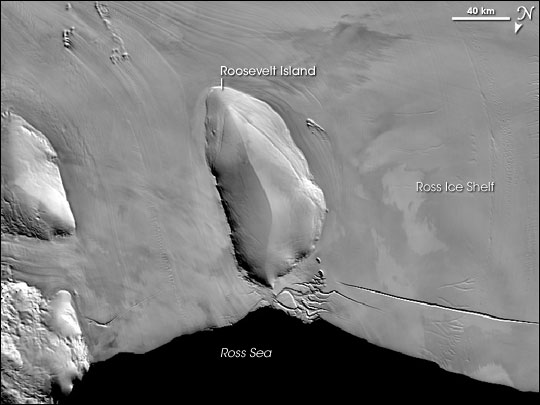

by Michon Scott · design by Robert Simmon and Michon Scott · April 23, 2007 In May 2006, Helen Amanda Fricker was doing the kind of work that left her perfectly open to a distraction. A geophysicist at Scripps Institution of Oceanography, Fricker didn’t doubt that her research was important, but she admits it was a little mundane. In an effort to improve Antarctic ice shelf maps and models of Antarctic tides, she was mapping the continent’s coastline by looking at small changes in elevation detected from satellite. |
|||
 | |||
Finding the precise outline of Antarctica can be tricky because the continent is fringed with ice shelves—thick slabs of ice, fed by glaciers, floating on the ocean surface. The shelves may hide the continent, but they do offer clues about where the land ends. The clue is that the floating part of an ice shelf moves up or down with ocean tides while the land-based part sits still. |
The coast of Antarctica is fringed by ice shelves that are thousands of feet thick in places. Fed by glaciers, these massive slabs of ice float on the surface of the ocean. Their elevation rises and falls with the tides. (©2005 BrynJ.) | ||
 | |||
Fortunately for Fricker, she didn’t have to stand shivering on an Antarctic ice shelf with a handheld GPS receiver to pick up the clues. Subtle changes in ice-shelf elevation from rising and falling tides are visible to NASA’s GLAS (Geoscience Laser Altimeter System) sensor on the agency’s ICESat satellite. The altimeter bounces a laser pulse off the Earth’s surface and times how long the signal takes to come back. Differences in the signal’s return times for the same location indicate changes in elevation. ICESat makes measurements for 33 days roughly every 4 months, collecting data over 70-meter-wide “footprints” every 175 meters along the satellite’s ground track. “So we got the same patch of real estate—or strip of real estate—surveyed every four months, and we could see how its elevation changed through time,” Fricker explains. In late May 2006, Fricker was concentrating on West Antarctica, around the Whillans and Mercer Ice Streams on the Ross Ice Shelf. She looked for the small elevation changes that would mark grounding lines, the place where the ice shelves stopped resting on land and started floating on the ocean. Marking the grounding lines would improve tidal models, which would improve understanding of ice shelf behavior, which influences glaciers, which influence sea level. Important work with a long-term payoff, but not terribly exciting. Then she found something she didn’t expect. Fricker found an elevation change, but two things about it struck her as weird. For one, it was in the wrong place—near a feature known as Engelhardt Ice Ridge—inland from where the ice shelf grounding line should have been. For another, the elevation change was far bigger than the typical tidal movement of 1 or 2 meters (3 to 6.5 feet). Between October 2003 and November 2005, the area she was examining had dropped roughly 9 meters (nearly 30 feet). “I wasn’t expecting to find this at all,” Fricker recalls. “I was shocked.” Something under the ice had to be moving. To figure out what was going on, Fricker needed a detailed, seamless map of Antarctica’s icy surface. Although precise, GLAS has a narrow view. A map of Antarctica made out of GLAS observations would look like the crisscrossing strings of a tennis racket. For a comprehensive view, she turned to the Mosaic of Antarctica (MOA), a detailed digital image of the continent based on data from the Moderate Resolution Imaging Spectroradiometer (MODIS) sensors on NASA’s Terra and Aqua satellites. “I plotted the place where I thought the elevation drop was occurring,” she says, “and lo and behold, it was sort of a flat region that showed up in MOA.” | The Ross Ice Shelf flows from land onto sea, encasing Roosevelt Island. In places where the thick ice hides the transition from land to floating ice shelf, scientists can locate the coastline by measuring changes in the ice shelf’s elevation. The floating part of the shelf rises and falls with the tides while the land-based parts sits still. (Image courtesy National Snow and Ice Data Center, Mosaic of Antarctica.) | ||
 | |||
Fricker contacted Ted Scambos at the National Snow and Ice Data Center, the scientist who had spearheaded the development of the Mosaic of Antarctica. Was he interested in helping her pin down the source of the elevation change? He was. |
The Geoscience Laser Altimeter System (GLAS) sensor on NASA’s ICESat satellite observes elevation over narrow swaths of the planet’s surface. This image shows GLAS orbit tracks (red lines) over Antarctica. (NASA image by the ICESat Science Team.) | ||